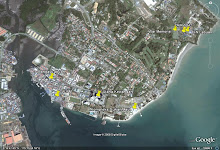9th May, 2008
Low-oxygen zones where sea life is threatened or cannot survive are growing as the oceans are heated by global warming, researchers warn.
Oxygen-depleted zones in the central and eastern equatorial Atlantic and equatorial Pacific oceans appear to have expanded over the last 50 years, researchers report in Friday’s edition of the journal Science.
Low-oxygen zones in the Gulf of Mexico and other areas also have been studied in recent years, raising concerns about the threat to sea life. Continued expansion of these zones could have dramatic consequences for both sea life and coastal economies, said the team led by Lothar Stramma of the University of Kiel in Germany.
The finding was not surprising, Stramma said, because computer climate models had predicted a decline in dissolved oxygen in the oceans under warmer conditions.
Warmer water simply cannot absorb as much oxygen as colder water, explained co-author Gregory C. Johnson of the National Oceanic and Atmospheric Administration’s Pacific Marine Environmental Laboratory in Seattle. There are complex biological and chemical interactions in these low-oxygen regions, Stramma said, adding that this needs to be more closely studied.
Frank A. Whitney of Canada’s Institute of Ocean Sciences said, “As oceans lose oxygen, this will reduce habitat for many organisms.” “Many species will lose their deep habitat, meaning competition will become stronger in the remaining favorable habitat, and increased vulnerability to predation will likely occur,” said Whitney, who was not part of Stramma’s team. He said the most rapid oxygen declines he has seen have occurred in the subarctic Pacific Ocean, and fish and crab kills have been reported in the last few years off Oregon.
Steven J. Bograd, a research oceanographer at the National Oceanic and Atmospheric Administration’s Environmental Research Division in Pacific Grove, Calif., called the finding “compelling” but not surprising.
Bograd, who also was not part of Stramma’s team, has studied trends in dissolved oxygen in the ocean off California, finding an expansion of the area of the continental shelf there that is exposed to low-oxygen conditions. “So, why should we care?” Bograd said. “Most marine species have minimum oxygen thresholds that they need for survival. As oxygen decreases, these animals will suffer and/or be compelled to move to other areas. Over time, the optimal area for various species will be compressed,” he explained.
Bograd’s findings are reported in a paper scheduled for publication in Geophysical Research Letters. “We are not able to say definitively what has caused the oxygen declines off California. But we do know that waters from the eastern tropical Pacific” – a reduced-oxygen area studied by Stramma – flow into this region, Bograd said.
“So, their results and ours are consistent,” he said, adding that there could also be other processes at work off California. The general pattern is for colder ocean waters in the north and south to absorb oxygen, cool and sink below the surface to then flow toward the equator, Johnson explained.
Along the way, organic matter drifts down into the deeper water and its decay uses up some of this oxygen. The oxygen balance depends on this movement and the amount of oxygen reaching the warmer waters, Johnson said, and this can be reduced if less is absorbed and moved in the deep currents.
“That means that eventually, at the end of the line, there will be less oxygen,” he said. In cold surface water, oxygen levels can reach as high as 300 to 400 micromols per kilogram, Johnson said. A mol of a gas such as oxygen occupies a volume of just under six gallons and a micromol is one-thousandth of that. A kilogram of water is the amount that would weigh 2.2 pounds.
Dissolved oxygen varies widely in the oceans, and sea life becomes stressed when it reaches between 60 and 120 micromols per kilogram. The researchers found concentrations as low as 10 in parts of the eastern Pacific and the northern Indian Ocean and larger areas in the Atlantic and Pacific were below 150.
Stramma’s team noted declines in affected areas ranging from 0.09 to 0.34 per year over the last half century. The research was funded by the German Research Council, U.S. National Oceanic and Atmospheric Administration and U.S. National Science Foundation.
(New Sabah Times @ 9/5/08)
Friday, May 9, 2008
Study: Warmer ocean water means less oxygen
Subscribe to:
Post Comments (Atom)















.jpg)



.jpg)


a.jpg)











.jpg)

.jpg)
.jpg)



















.jpg)
.jpg)

























No comments:
Post a Comment